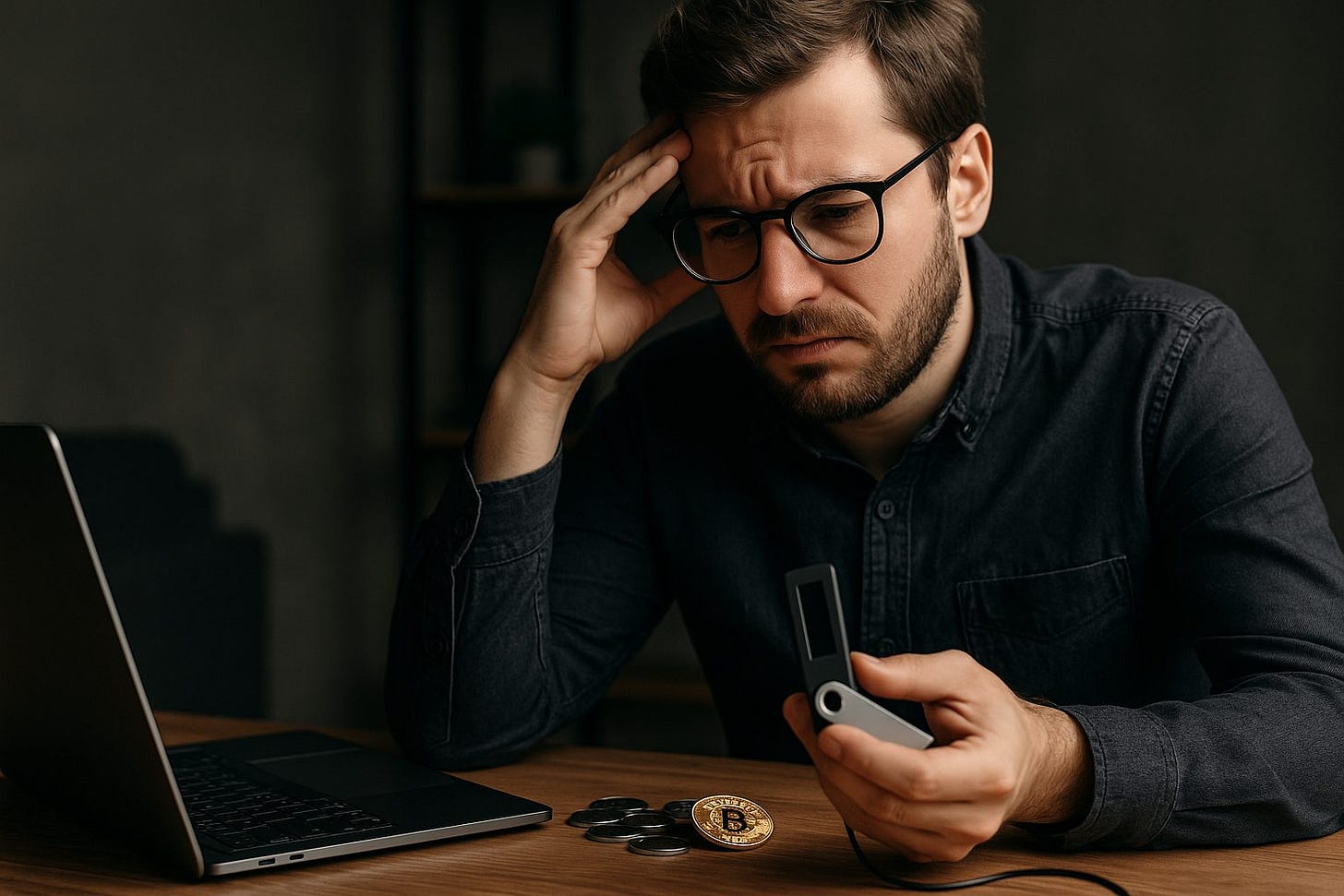5 Crypto Wallet Mistakes That Are Secretly Costing You Money
Unlocking value by sidestepping hidden dangers 🔐
I think we all want to believe that owning cryptocurrency is as straightforward as buying stock, but let me tell you: it's more like defusing a bomb—bright lights, high stakes, zero room for error. Crypto wallets might seem user‑friendly, but a single misstep can zap your funds into the void. And yes, those tiny, secret errors? They're the ones that quietly drain your wallet—while you binge memes on Twitter.
Ready to save yourself from regret and actual dollars disappearing? Let's dig into five wallet mistakes that are costing you right now.
1. Falling for Fake Wallets & Browser Extensions 🕵️♂️
Picture this: you're searching for MetaMask in Firefox, click what you think is the legit extension… boom—seed phrase gone. Hackers have taken fake-wallet scams mainstream—especially on Firefox, where malicious extensions nearly perfect the disguise. One click and your credentials vanish into a hacker's wallet.
And it's not just extensions. Fake desktop apps are hitting Mac users hard—especially counterfeit versions of Ledger Live that prompt for your seed phrase. Here's why this is maddeningly effective:
They imitate the real interfaces.
They trick you into "error" popups asking for your phrase.
You send them your keys—poof, funds gone.
What to do:
Only install extensions and apps from official sites.
Bookmark official URLs; never click ads or search result links.
Stay vigilant. Every request for your seed phrase? Scam. Any ask is fatal.
2. Neglecting Backups & Upgrades
Skipping a firmware update or burying your seed phrase in your Notes app? That's the crypto equivalent of leaving your car unlocked in a rough neighborhood.
Hot wallets are fancy and convenient, sure. But trust falls apart fast if your backup is weak. Users regularly lose access because they stored seed phrases insecurely—or didn't back them up at all. And firmware? Flaws exist, zero‑day threats abound.
Take action:
Write down your 12–24‑word backup on paper—or, better yet, a steel plate.
Test your recovery phrase by restoring periodically—but only with caution.
Update software regularly—ignore it at your own peril.
3. Overlooking Physical Security—"Wrench Attacks"
Digital is only half the battlefield. The real threat? You—or your wallet—being physically threatened. So‑called "wrench attacks" are on the rise, where criminals seize private keys by force.
It sounds like something out of a spy thriller, but it's real: investors are kidnapped, home-invaded, even tortured to hand over hot‑wallet credentials.
Defensive steps:
Use multisig (multiple‑signature) wallets—no single key release.
Keep private keys secure and hidden.
Stay discreet—don't brag about crypto on public forums or socials.
4. Clipboard Hijacks & Address Poisoning
Send funds to the wrong address? That's not a typo—it could be an attack. Clipboard hijacking malware like "EthClipper" intercepts your address copy‑paste and substitutes a malicious address; you don't even notice. Another nasty trick: "blockchain address poisoning," where attackers flood recent addresses with lookalikes, tricking your wallet into selecting the wrong one.
These attacks are silent and swift. One wrong paste, and your coins are gone—with no recourse.
Safeguard yourself:
Always double‑check the first and last 4–6 characters of the address.
Use hardware wallets with confirmed screen displays.
Copy‑paste with caution—especially on public devices.
5. Weak Authentication & SIM Swaps
Yes, 2FA is essential—but using SMS as your only method? High‑risk. SIM‑swap attacks let hackers take over your phone number and bypass authentication. Even VPNs won't save you if your second factor is compromised.
Smart moves:
Shift to app‑based 2FA: Authy, Google Authenticator, or open‑source options.
For critical accounts, add a hardware key like YubiKey or Ledger Stax.
Make backup codes, store offline, in a fireproof safe.
Why It Matters: The Hidden Cost
These mistakes aren't hypothetical—they're bleeding real money out of wallets every day:
Tasmanian CATM users lost hundreds of thousands to ATM scams.
U.S. crypto users lost $9.3 billion to scams in 2024, a 66% year‑over‑year jump.
Scams and phishing schemes cost investors nearly $4 billion in 2023—and could hit $12 billion in 2024.
This isn't just "volatile market risk." It's structural—hackers, scammers, and robbers are striking where you least expect it. Trusting your wallet without respect for these threats? That's asking for trouble.
Also read: 7 Things to Check Before You Ape Into Any New Coin
How to Bullet‑Proof Your Wallet
Vet everything – install only trusted apps/extensions, bookmark real URLs.
Harden backups – use multiple offline backups on paper/metal.
Upgrade regularly – firmware, apps, everything.
Go multisig – don't put all the keys with one person or device.
Use beefy 2FA – app‑based + hardware keys; ditch SMS.
Check every address – visualize full addresses on device, never rush.
Stay low‑key – no social spoilers, no boasting.
Final Thoughts
Crypto is exciting. It feels modern, decentralized—a frontier of freedom. But with that freedom comes responsibility. It's not enough to have a wallet. You must treat it like your bank vault. Because really—if you mess up, there's no customer service line to call.
These five mistakes are stealth drains, making your money disappear in ways you might not even notice—until it's too late. But awareness is power. Each practice you adopt seals a crack. Each layer you add makes your crypto fortress stronger.
So—ask yourself: am I storing my seeds right? Am I running the real version of my wallet? Am I ignoring my phone's 2FA weakness?
Fix one thing today. Then the next. And soon? You're not just holding crypto. You're securing it—smartly, safely, and with swagger.
Your next move:
💡 Audit your wallet now—check backups, update as needed.
🔐 Consider switching to hardware + multisig if you haven't already.
👇 Comment below with your biggest crypto security scare—or tip others with your best defense trick!
Stay sharp. Stay safe. And keep your crypto—and your confidence—in good hands.


